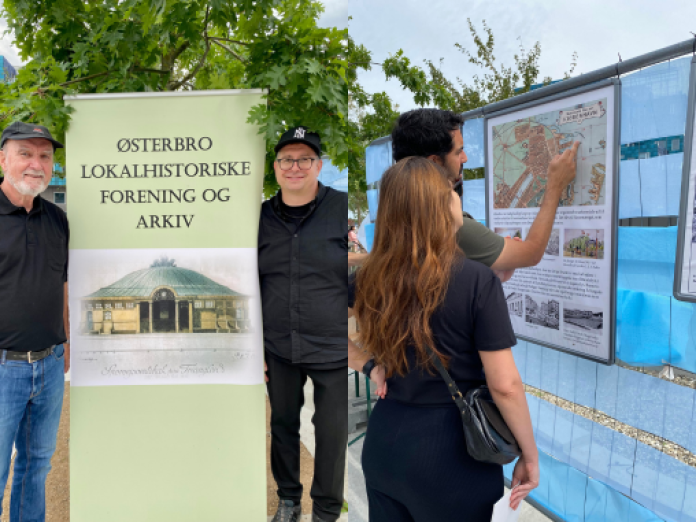Meet last year's participants: Østerbro Local History Archive

Interview with Peter Saxov and Morten Lander Andersen from Østerbro Local History Association and Archive
Do you know Nordhavn's fascinating history? At the Kulturhavn Festival, Østerbro Local History Association and Archive told about the area's exciting history, which, among other things, contains a huge sabotage action during the Second World War.
Here, Peter Saxov and Morten Lander Andersen explain why it is important and interesting to preserve knowledge about the history of local areas:
When the Kulturhavn Festival is held down by the harbour, it is natural that we look at the harbour's history. Nordhavn is incredibly exciting: it has gone from being a small shooting harbor with a repair yard to growing up and being a free port with enormous activity over the course of a few hundred years. And now that it has completely changed and is no longer a port, but a district.
History is an important element of our entire existence. The prerequisite for being able to develop forward is that you have your history with you. You must also have that for your port and your local area.
Nordhavn's history is also Denmark's history and indeed world history. There were prisoners from the German prison camps during WW1 – some all the way from China who ended up here because it was the only place with working infrastructure.
From World War II we have the remains of the Riffel Syndicate, which is a Danish arms factory that produced an insane amount for the Germans. That building is, among other things, became Meny and all the surrounding red buildings are the remains of the factory.
The rifle syndicate was exposed to the biggest act of sabotage during the occupation, because the resistance movement did not care about the factory. 400 kg of explosives - it's crazy to use that much. You had no idea what would happen if you fired so much. But it was not possible to raze it to the ground, because the factory was up and running again before the end of the war and the supporting columns are still standing inside the building.
Today, very exciting architecture is being created in Nordhavn. We are standing next to Copenhagen International School, which changes color all the time because it reflects and reflects the light from the water. And Orientkaj Metrostation is an insanely beautiful metro station. It is white with inspiration from a small Utzon corner down in Kalkbrænderihavnen, where Jørgen Utzon has built a house and his son and daughter have continued to build.”
Why is the port's history exciting to delve into?
When Kulturhavn Festival is held down by the harbour, it is natural that we look at the harbour. Nordhavn's history is incredibly exciting: it has gone from being a small shooting harbor with a few repair yards to growing up and being a free port with enormous activity over the course of a few hundred years. And now that it has completely changed and is no longer a port, but a district.
And it's fulfilled port, all of it. It is Østerbro that has been expanded by building an industrial port. First Nordhavn in the 1880s and then Copenhagen's Frihavn in the 1990s. Which expands and expands. Which is getting bigger every day because waste is taken out, which expands Nordhavn.
Kronløbøen: piling walls were erected, the water was pumped out and filled up.
History is an important element of our entire existence. The prerequisite for being able to develop forward is that you have your history with you. You must also have that for your port and your local area. You get that by preserving your local history. The history of the harbor is also Danish history and it is also world history.
Prisoners from the German prison camps in World War I who end up here because it is the only place you can be shipped out and come home. There are some all the way from China who end up here to come home because it's the only place where the infrastructure works.
And from World War II we have the remains of the Riffel Syndicate, which is a Danish arms factory that produced an insane amount for the Germans. That building has become Meny and all the surrounding red buildings are also the remains of the Rifle Syndicate.
They were exposed to sabotage, because the resistance movement didn't care about that, so it is the biggest act of sabotage in the entire history of Denmark during the occupation. 400 kg of explosives, it's crazy to use that much. You had no idea what would happen if you fired so much. So, 1 kg. it was wild. 400 kg. was absurd. But it was not possible to raze it to the ground, because the factory was up and running again before the end of the war and the supporting columns are still standing inside the building.
Is there anything else you can highlight about Nordhavn?
Very exciting architecture is being created in Nordhavn. We stand next to the international school, which changes color all the time. Then it is green, then it is blue, because it reflects and reflects the light from the water.
And then there is Orientkaj Metrostation, which is an insanely beautiful metro station. It is white because all the new metro stations have a color in relation to something interesting around them. And that's because if we go down to Kalkbrænderihavnen, we find a small Utzon corner, where Jørgen Utzon built a house and his son and daughter built further. It is completely white, so those who built the metro station have drawn inspiration from there, to honor Utzon.